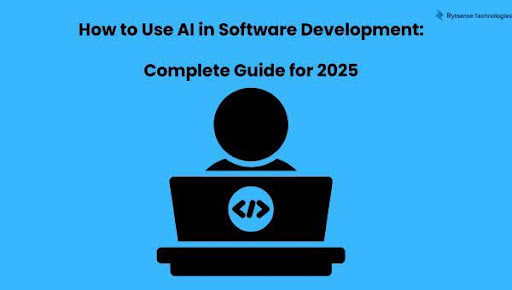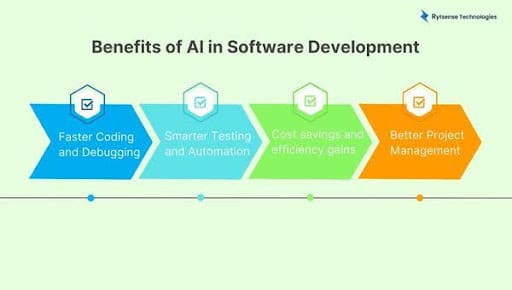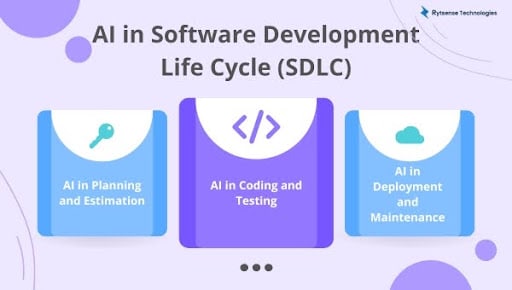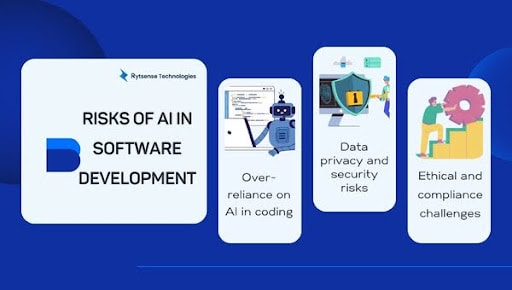-
Key Takeaways
- AI increases developer productivity and works by 55% and reduces development costs by 30% through coding, testing and debugging.
- Knowing how to use AI in software development is vital to stay competitive.
- Begin small with free AI tools such as ChatGPT and GitHub Copilot for coding assistance.
- Adopting AI early is your survival strategy for growth in 2025 and beyond.
- Review and understand AI generated code for avoiding over reliance risks, security protocols, and maintaining your coding skills.
- AI may transform entire software development lifecycle planning and coding to testing and deployment
How to Use AI in Software Development: Complete Guide for 2025

Artificial Intelligence is reshaping software development faster than anyone imagined. By early 2024 we’ve seen 256 billion lines of AI-generated code produced, and new GitHub studies indicate that developers leveraging GitHub Copilot report productivity surges of nearly 55%. How to use AI in software development is no longer an optional advantage; it’s an essential requirement for keeping pace in the industry. It will show you which platforms to start with, the step-by-step workflows that incrementally build your skills, and the pitfalls that early adopters frequently encounter and how you can sidestep them.
Building software has always meant solving puzzles and crafting answers. These days, AI is enhancing that journey. When you know or learn to weave AI into your workflow, you unlock a treasure with shortcuts and smart features that felt like science fiction yesterday.
Why AI is becoming essential in modern software engineering
AI in software engineering is blowing up. Firms that adopt AI wrap up projects 40% sooner than those that resist. The secret? AI automates dizzying phases of the job: it drafts functional code, sniffs out bugs, runs tests, and even sketches out the project rope. Look at it as a brainy buddy that spins up code at midnight and never hits pause.
Modern AI software development face huge challenges every day such as looming deadlines, tricky requirements, and the pressure to write flawless code in record time. AI swoops in to make things way easier by automating the dull stuff and serving up smarter solutions. Mastering AI in the software-building process means spending less time on copy-paste chores and soaking up more moments of pure creativity instead.
Quick Overview of AI’s Impact on Businesses
Businesses are posting jaw-dropping numbers after getting the hang of AI in dev. Reports show millions saved and project ship dates moved up by months. AI spots sneaky bugs before they ever bother users, pushes code quality to new levels, and even imagines the features customers are most likely to fall in love with.
Cool startups can finally run games next to the industry giants because AI tips the scales in their favor. A five-person crew armed with AI can outpace a twenty-person squad without it. This is why knowing AI’s moves is quickly turning into the must-have badge every coder needs to wear with pride.
Benefits of AI in Software Development
The benefits of ai in software development are rewriting the rules of the software classic. Let’s check out the top benefits that prove AI is no longer a bonus; it’s the backbone of every championship dev team.

Faster Coding and Debugging
Using AI in software development helps you move fast. AI code helpers can write whole sections of code in a few seconds. You write a short note about what you require, and the AI builds the entire function for you. That way, you may add new features in a few minutes instead of spending hours.
Finding and fixing mistakes is also quicker. AI tools check your code for errors even before you launch the program. They catch common bugs, offer fixes, and explain the problem. Learning this trick can cut your debugging time by half and help you code with more confidence.
Smarter Testing and Automation
In the past, testing software could drag on for weeks. Now the AI steps in and automatically builds test cases, running thousands of them in just a few minutes. That fastens the whole quality-check process. AI even figures out which parts of the code are likeliest to have bugs and focuses its tests on those areas, so you catch issues before users do.
AI testers act such as real users like human; they tap buttons, fill out forms, & scroll through your app exactly how someone on the street would. This means sneaky glitches that human testers might overlook get flagged long before your app goes live. Master this AI power in your development toolkit, and you’re delivering apps that users trust with way less work.
Also Read:
AI developer salaryCost savings and efficiency gains
Software projects burn through budgets quickly. AI is the extinguisher. The way AI drafts code, runs through tests, and smooths out post-launch fixes saves teams time and cash. That adds up to the project costing less and showing value way sooner.
Plus, think dollar insurance: AI spots bugs before they balloon and steers teams to cleaner code paths, which saves bailing-out money later. Teams savvy with AI often see expenses drop later by more than 30%.
Better Project Management
Juggling development projects is like herding cats. Enter AI, the assistant that turns chaos into order. The system estimates how long features really need, nudges you before trouble spots, and recommends the right teammate for each task. The result? Smoother projects, smarter timelines, and happier teams. That’s how AI saves the budget and keeps your project on the bull’s-eye.
AI works like a smart analyzer for software projects, looking at old builds to guess how long new features will really take. It can sound the alarm if a deadline is slipping and hand over tips to get things rolling again. When you learn to use AI this way, hitting your launch goal becomes a lot easier.
Ready to speed up your development process?
Discover how AI can cut coding time and boost quality.
AI in Software Engineering: Transforming the Development Process
AI is behind most of the clever shortcuts in the way we create apps. Every single phase, from the initial sketch to the shipped update, gets faster and smoother with its help.
AI for Requirement Analysis
Great software starts with a clear picture of what users need. To paint that picture, AI in software engineering sifts through reviews, market scans, and company priorities. It digs through mountains of data to spotlight the features that nearly every hand would vote for.
Once you know how to let AI handle this discovery phase, you only code what customers really want. Even cooler, AI warns developers when a requested feature is likely to change, letting you reframe sprints and timelines right away. This careful prep means the final app is the real deal, solving the problems people complain about instead of piling on extras no one uses.
AI in Design and Architecture
Creating software architecture once demanded long years of mentorship and trial-and-error. With today’s AI tools, the same designers can receive instant suggestions for the best system blueprints simply by stating the project’s goals. The tool scans the lessons of countless successful projects, spotting patterns that experienced architects once learned only after painstaking practice, and then delivers the design most likely to succeed in your project’s unique context.
When a developer learns to lean on AI for architecture, the choice of structure can be settled in moments rather than weeks. The system forecasts where delays will clog the pipeline, flags weak spots in scalability, and recommends defenses against ever-growing junk of security threats. Waters once thought turbulent become calm, leading the final system to be simple, clear, and easy for any future developer to maintain.
AI-Driven Development Practices
Software engineering is rapidly adopting a new hand: the AI that shapes, suggests, and supports the code itself. Its techniques include instant code building from a short example, gentle rewrites that tidy code without losing intent, and the production of classroom-doc-quality comments that explain intent. Through these tools, software teams code faster, keep the code lighter for future updates, and still meet slightly tighter deadlines.
When a group learns to train the AI tool rather than simply letting it work, the final output consistently rises in integrity. The AI, ever polite, recalls best practice each moment and delivers gentle nudges, avoiding the older, ugly code, and an ever-ready slate of attached experiments to sharpen performance. For teams, the workday itself feels refreshed, partners are less fatigued, and output is closer to the highest vision than to strict checklist wins.
Also Read:
AI product developmentAI in Software Development Life Cycle (SDLC)

The ai in software development life cycle, the step-by-step transformation from vision to working system, now succeeds under the watch of a swift, intelligent guide. Let’s explore the improvements each unique stage collects from its subtle partnership.
AI in Planning and Estimation
Getting a software project plan right is tricky, even for experts. Now AI is changing that. By combing through old project data, AI spots similar tasks, sizes, and snagging timelines in seconds. It gives teams a clear guess at timelines and a thoughtful inventory of who and what they’ll need for each phase.
Smart use of this forecasting keeps expectations in check and prevents meltdowns. Mondays are full of surprises. The same AI takes a quick tour at project kickoff to spotlight potential risks. It gives a starter kit of fixes, leaving teams calmer and customers happier.
AI in Coding and Testing
Coding is where AI takes center stage. AI assistants sit side by side with programmers, suggesting chunks of already-tested code while learning the writer's style. By fixing typos, suggesting better loops, and polishing performance in the background, AI slashes development time and bugs. Testing evolves, too. The AI scans product screens and past risks to whip up test scenarios no human test lead would think of in a hurry. It balances the test portfolio to give focus to tricky parts, running the scripts around the clock. Nail the AI parts in both coding and testing, and the software is released faster with quality that feels effortless.
AI in Deployment and Maintenance
When it comes towards rolling out & keeping software running, if you have AI in your toolbox, it makes the job smoother. During the AI software development life cycle, the deployment phase uses AI in ways like self-driving deployment pipelines, smart monitoring, and forward-looking tune-ups. The coolest part: AI can spot in advance when something is about to break and tell you how to fix it before it causes trouble.
By understating or learning to rely on AI for getting software out the door & keeping it in shape, you may cut down on surprises and make life good for your end users. The AI nose never stops sniffing for issues, sending an alert before a glitch gets the chance to ruin someone’s good day. This kind of head start helps your software keep running like a well-oiled machine.
Also Read:
AI Development CostFree AI Tools for Software Development
Jumping into AI-powered software development is simple now that you can grab free ai tools for software development for no cost at all. You don’t need a giant budget anymore; today’s AI helpers are ready to work on anything from a one-person weekend project to a mega team of engineers.
Popular Free AI-Powered Coding Assistants
A handful of top-notch, free ai software development tools can make your coding faster and smarter. GitHub Copilot, for example, has a no-cost tier that serves smart autocomplete suggestions straight into your code editor as you type. These AI helpers study millions of GitHub repositories, so the code they recommend is not only smart, it’s also well-tested and ready for you to drop into your project.
If you want to make your coding life a little easier, you should check out free ai tools for software development that help you write better software. Tabnine offers a free version that finishes your code for you, while OpenAI’s ChatGPT can answer tricky programming questions and help you debug. Learning to use these tools builds a strong base for creating awesome projects.
Free testing and debugging AI tools
You can supercharge your testing and debugging, too. DeepCode, now part of Snyk, lets you run a free static analysis scan that catches bugs and security holes faster than you can read a stack trace. Just upload your code, and it’ll offer neat little fix suggestions for common issues.
Some other smart debugging tools can even read error messages, explain them, and point to the likely line that needs fixing. Once these skills are under your belt, fix-up sessions shrink, so you can keep focusing on adding new features. The best part is most of these free AI developers plug right into the code editors and IDEs you already use.
Limitations of free tools
Still, keep your expectations in check. The free tiers usually cap how many lines you can scan, limit advanced features, give you only basic help options, and may skip some languages. They also might not work with all the tools in your coding ecosystem, so reading the fine print can save you a headache later.
Looking to experiment without spending a dime?
Start using free AI tools to power up your coding today.
Best AI Software Development Tools (Paid & Enterprise)
Knowing when to stick with free AI tools for software development and when to switch to a paid version is a skill every coder should develop. Free versions work the best for students, hobby projects, and anyone who is just dipping their toes into AI-assisted coding. Once your project or your team gets bigger, or you simply want the latest bells and whistles, it’s time to check out the paid tools.
The best enterprise grade AI tools for software development pack a punch of advanced features that the free versions can’t always deliver. They’re built for pro development squads and for the gigantic projects that make or break businesses.
AI code generation tools
If you want to supercharge your coding, look at paid AI code-generation tools such as GitHub Copilot Pro, Amazon CodeWhisperer, and Tabnine Pro. These versions provide much tighter suggestions, cover more programming languages, and slide effortlessly into the development environments that big teams already use.
Learning or understanding to work with a professional AI code-generation tool can free you and your teammates from a lot of mundane tasks. These tools may “read” your organization’s codebase, so they learn how your team writes functions, names variables, and structures its classes. The AI then suggests new code that follows those same patterns. The result? Code that’s clean, predictable, and easier to maintain from sprint to sprint.
AI Project Management Platforms
Today’s AI-powered software development environments come built-in with great project management features. Tools like Jira that add AI plugins, Linear, and Monday.com forecast project schedules, highlight logjams, and streamline team activities by using machine-learning smarts.
Getting to grips with AI in software project management keeps teams on track and on budget. The software assesses team patterns, estimates dangers, and recommends task pairings, creating smooth, speedy development cycles and stronger team cooperation.
AI-Powered CI/CD Tools
Continuous integration and continuous delivery are levelled up thanks to machine-learning tools. Systems like Jenkins with AI enhancements, CircleCI, and GitLab CI/CD smartly speed up builds, foresee breakdowns, and automatically steer deployment.
Mastering AI in CI/CD pipelines helps groups push updates more quickly and reliably. The software finds risky code commits in advance and proposes testing methods, so defects rarely hit live code boosting software quality across the board and protecting users.
How Can AI Help Software Development Teams?
Knowing how AI can boost coding squads is key to building that killer app everyone wants. AI’s help isn’t just auto-filling functions anymore; it’s rewiring how teams code, chat, and choose tech.
Improving collaboration
How can AI turbo-charge teamwork on coding teams? Smart bots scan chat logs and calendars, pick the best 30 minutes for everyone, and break down geek-speak for non-developers, all in one sweep. Docs that update when the code does stop the “did I miss an update?” frenzy and keep the how-to guide reflective of the now, not the yesterday.
When groups dig into AI-powered collaboration for code, they stop wasting time on “who’s doing what?” and glide instead into fast, focused building. AI spots missing skills, nudges the crew toward a fun online course, or links them with that elusive front-end wizard, making the whole crew level up faster.
Enhancing decision-making with data-driven insights
How can AI lend a hand when it’s time to pick? The tech digs through mountains of code logs, pull requests, and bug reports, pointing out what the human eye often skips: “This design will handle millions of users, the other one will stagger.” It can highlight the perfect new library every coding library dreams of, or say, “Trust me, focus on feature A; it’ll score the most user love.”
Teams that know how to use AI in software development build stronger products. When developers use AI to look at user habits, how software is performing, and what competitors are up to, they discover which features to work on first. This data-driven roadmap results in apps that feel right for users and help their companies grow.
Automating repetitive development tasks
How can software developers spend less time on chores and more time inventing? AI is excellent at turning dull, routine jobs into quick clicks. It can whip up standard code pieces, refresh user manuals, test bits of code, and keep track of system health.
When AI takes over the grind, developers can tackle the exciting puzzles that require real brainpower. AI can run code reviews, write summaries for new software versions, and even build helpful user guides. Teams report happier coders and products that reach customers sooner.
Risks of AI in Software Development

Even with the perks, AI comes with shadows that teams must see and manage to use these tools safely and well.
Over-reliance on AI in coding
One big threat of using AI for writing software comes when programmers let it produce code they never examine. If teams chase a fast solution by copying AI suggestions word-for-word, they can sneak bugs, big security holes, or clunky and slow code right into the product. Over time, those mistakes burn more hours when fixes arrive too late.
Staying smart regarding AI means viewing it as a top-notch helper, not a mind to lean on. Before code touches the project, a human reads, tests, and grasps every suggestion. By practicing our own coding skills and keeping questions alive, we keep the AI in check and the software stronger.
Data privacy and security risks
Another danger lies in keeping private data and secure code private. When AI tools analyze a line of code to give advice, they sometimes send that line to a server we can’t completely trust. Sensitive business rules and secret patterns could slide through that window; that’s a nightmare for teams writing everything from banking apps to games that save the player’s email. Always check an AI tool’s privacy settings, and when in doubt, a real developer should make the code from scratch.
When you know which security rules to follow while using AI for software development, you pick apps that keep your ideas safe and follow rules about privacy. You can avoid big headaches by using software that keeps your data on your own computer or that clearly promises to protect your information. Always read how the tools you want to use tackle data privacy before you agree to anything.
Ethical and compliance challenges
When software tools use AI, there are also tricky questions about who really owns the code, who is responsible if the code has problems, and which licenses you need to follow. Some AIs learn from code that isn’t free for everyone, and that can lead to trouble if you are working on a commercial app. Knowing how to use AI in software development fairly means spotting these questions early. You can limit surprises by working only with trustworthy tools, writing down any code the AI helped with, and asking a lawyer when the rules get complicated.
Future of AI in Software Development
Looking ahead, new ideas and inventions will make AI even more a part of how we build software. The next version of these tools promises to help creators work faster, write machine code with more confidence, and even test apps before they are built.
AI-Powered Autonomous Coding
Imagine a world where software gets built almost entirely by bright AI minds while you sip coffee. Programs of tomorrow will look at a few sentences of what you need, then whip up whole applications, tests, instructions, and steps for going live in minutes. You’ll spend more time relaxing and less time squinting at code.
Coders get to dream up the tricky stuff while curious food truck owners or teachers build the next game or secret startup in no time. Software will bloom everywhere, speeding up everything from hospitals to baker's shops and changing what the whole world knows as programming.
Generative AI for Software Design
AI is about to step onto every design whiteboard and turn chat messages into stunning screens. Just drop a few lines about the mood and purpose, and the AI sketches user menus, pop-up alerts, and neon-blue light themes faster than you can order lunch. Soon, these tools will remember who is color-blind, what brand products you sell, and how to keep tiny fingers from guess-clicking the whole checkout page.
That means company interns or late-night hobbyists can look like design pros as they share perfect prototypes and get feedback at Internet lightning speed. Design talent, just like code talent, will be everywhere, all because a friendly AI jumped to lend a smooth hand.
AI in continuous delivery and DevOps
Using AI inside the DevOps pipeline will completely change our approach to delivering software. Deep learning models will choose the best deployment paths, recommend just the right amount of cloud resources, and automatically grow compute power when requests spike. Supervised monitoring will find and fix bugs in the shadows, keeping the software healthy long before the user notices a problem.
Eventually, AI could grab the whole lifecycle of software in one hand, shepherding everything from the push of new code to a user-ready release and daily patching. We’ll get packages to customers faster, smoother, and with barely anyone pressing buttons.
Conclusion: How to Use AI in Software Development Effectively
To get the most from AI in software building and how to use AI in software development, we must treat the code-crunching machine as a teammate and not a master. Blend the AI’s scale & focus with human intuition, creative and imagination. You can also take help of Rytsense Technologies, if you look forward to using AI in software development or you look for best AI development company in USA. When we see AI as a helper that lifts us, speeds us, and spots gaps we can’t, we level up our skills and creativity, not trade them away.
Curious about what’s next in AI-driven coding?
Stay ahead with the latest trends shaping the future of software development.

The Author
Karthikeyan
Co Founder, Rytsense Technologies